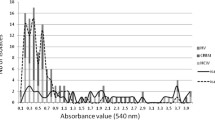Abstract
In order to expand the present knowledge of the pathogenic potential of Blastoschizomyces capitatus in central venous catheter (CVC)-related bloodstream infections, six strains of the organism recovered from three leukemic patients with CVC-related fungemia in different years were investigated. Isolates and control strains were tested for their genetic relatedness and for their ability to produce slime in glucose-containing solutions. DNA restriction enzyme analysis revealed that all strains of B. capitatus were identical, whereas slime production assays and examination of ex vivo material showed that they were able to produce large amounts of slime. Slime production may therefore play a relevant pathogenic role in cases of CVC-related fungemia caused by B. capitatus.


Similar content being viewed by others
References
Chamel H (1993) Fungal infections in the immunocompromised host: clinical syndromes and diagnosis. In: Murphy JW, Friedman H, Bendinelli M (eds) Fungal infections and immune responses. Plenum, New York, pp 405–424
Goldmann DA, Pier GB (1993) Pathogenesis of infections related to intravascular catheterization. Clin Microbiol Rev 6:176–192
D’Antonio D, Romano F, Pontieri E et al (2002) Catheter-related candidemia caused by Candida lipolytica in a patient receiving allogenic bone marrow transplantation. J Clin Microbiol 40:1381–1386
Lecciones JA, Lee JW, Navarro EE et al (1992) Vascular catheter-associated fungemia in patients with cancer: analysis of 155 episodes. Clin Infect Dis 14:875–883
Polacheck I, Salkin IF, Kitzes-Cohen R, Raz R (1992) Endocarditis caused by Blastoschizomyces capitatus and taxonomic review of the genus. J Clin Microbiol 30:2318–2322
Martino R, Salavert M, Parody R et al (2004) Blastoschizomyces capitatus infection in patients with leukemia: report of 26 cases. Clin Infect Dis 38:335–341
D’Antonio D, Piccolomini R, Fioritoni G et al (1994) Osteomyelitis and intervertebral discitis caused by Blastoschizomyces capitatus in a patient with acute leukemia. J Clin Microbiol 32:224–227
Maki DG, Weise CE, Sarafin HW (1977) A semiquantitative culture method for identifying catheter-related infections. N Eng J Med 296:1305–1309
Branchini ML, Pfaller MA, Rhine-Chalberg J, Frempong T, Isenberg HD (1994) Genotypic variation and slime production among blood and catheter isolates of Candida parapsilosis. J Clin Microbiol 32:452–456
Pontieri E, Sferra R, Vetuschi A et al (1998) Variation of slime production and ultrastructural analysis in clinical and soil isolates of Candida parapsilosis. Microb Ecol Health Dis 10:17–24
Malick LE, Wilson RB (1975) Modified thiocarbohydrazide procedure for scanning electron microscopy: routine use for normal, pathological, or experimental tissues. Stain Technol 50:265–269
Marrie TJ, Costerton JH (1984) Scanning and transmission electron microscopy of in situ bacterial colonization of intravenous and intra-arterial catheters. J Clin Microbiol 19:687–693
Carruba G, Pontieri E, De Bernardis F, Martino P, Cassone A (1991) DNA fingerprinting and electrophoretic karyotype of environmental and clinical isolates of Candida parapsilosis. J Clin Microbiol 29:916–922
Pfaller MA, Messer SA, Hollis RJ (1995) Variations in DNA subtype, antifungal susceptibility and slime production among clinical isolates of Candida parapsilosis. Diagn Microbiol Infect Dis 21:9–14
Acknowledgements
We are indebted to R.M. Mancini, for careful editing of the manuscript.
All of the authors are funded by ordinary institutional grants without any specific reward for this publication. Editorial expenses are covered by the Associazione Donatori Sangue (FIDAS), Via Fonte Romana 8, 65100 Pescara, Italy.
Author information
Authors and Affiliations
Corresponding author
Rights and permissions
About this article
Cite this article
D’Antonio, D., Parruti, G., Pontieri, E. et al. Slime production by clinical isolates of Blastoschizomyces capitatus from patients with hematological malignancies and catheter-related fungemia. Eur J Clin Microbiol Infect Dis 23, 787–789 (2004). https://doi.org/10.1007/s10096-004-1207-4
Published:
Issue Date:
DOI: https://doi.org/10.1007/s10096-004-1207-4




